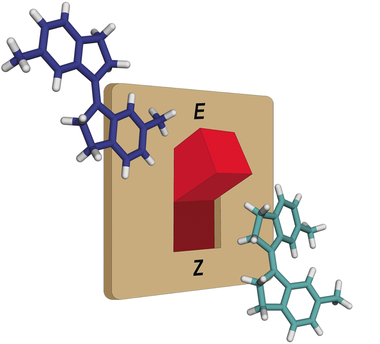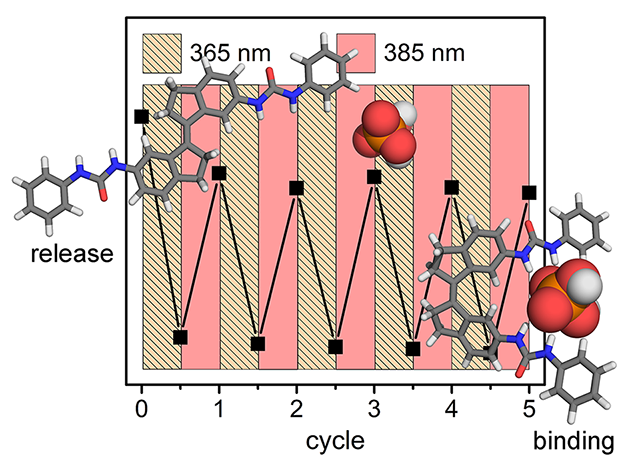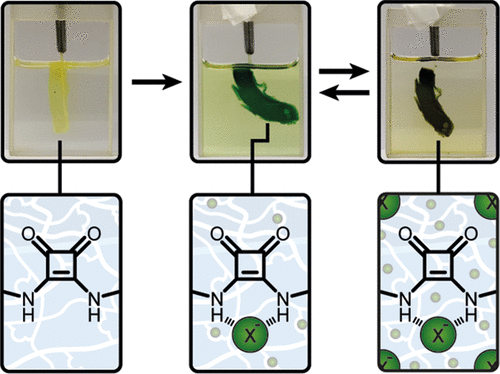Artificial Molecular Switches and Machines
 Light-driven molecular switches and machines are increasingly applied to control dynamic functions through incorporation into synthetic materials and pharmaceuticals. However, currently available systems have limitations in terms of excitation wavelength needed (UV light), photostability, and photoconversion efficiency. We are therefore optimizing known — as well as exploring new — molecular switching motifs. In addition, we have high interest in modulating light-induced switching processes by orthogonal chemical stimuli to increase control levels and create artificial photocycles, enabling unidirectional substrate translocation.
Light-driven molecular switches and machines are increasingly applied to control dynamic functions through incorporation into synthetic materials and pharmaceuticals. However, currently available systems have limitations in terms of excitation wavelength needed (UV light), photostability, and photoconversion efficiency. We are therefore optimizing known — as well as exploring new — molecular switching motifs. In addition, we have high interest in modulating light-induced switching processes by orthogonal chemical stimuli to increase control levels and create artificial photocycles, enabling unidirectional substrate translocation.
Selected key publications:
I.M. Bekaert, et al., Org. Lett. 2025, 27, 3612-3616 🔗
N. Duindam, et al., J. Am. Chem. Soc. 2023, 145, 21020-21026 🔗
D. Villarón, et al., Chem. Eur. J. 2021, 27, 17346-17350 🔗
Stimulus-Controlled Anion Binding and Transport
 The transport of anions across the cell membrane, which is mediated by transport proteins, is of fundamental importance to many biological processes. Dysregulation of such transport has been associated with various diseases, for example, cystic fibrosis. In this research theme we employ artificial molecular switches and machines to create anion binding and transport systems which respond to external stimuli such as light and pH change. Our main interest is to use these to influence the biological processes that are associated with transmembrane anion transport, providing a new approach to disease treatment.
The transport of anions across the cell membrane, which is mediated by transport proteins, is of fundamental importance to many biological processes. Dysregulation of such transport has been associated with various diseases, for example, cystic fibrosis. In this research theme we employ artificial molecular switches and machines to create anion binding and transport systems which respond to external stimuli such as light and pH change. Our main interest is to use these to influence the biological processes that are associated with transmembrane anion transport, providing a new approach to disease treatment.
Selected key publications:
J.E. Bos et al., J. Am. Chem. Soc. 2024, 146, 31085-31093 🔗
J. de Jong et al., Angew. Chem. Int. Ed. 2024, 63, e202316628 🔗
J. de Jong, et al., Chem. Rev. 2023, 123, 8530-8574 🔗
S.J. Wezenberg, et al., J. Am. Chem. Soc. 2022, 144, 331-338 🔗
D. Villarón, et al., Chem. Sci. 2021, 12, 3188-3193 🔗
Dynamic Polymer and Supramolecular Materials
 Polymeric and supramolecular structures that adapt to constantly changing environmental stimuli will be at the basis of a new generation of synthetic materials. We incorporate artificial molecular switches and receptors into soft and solid materials (e.g., gels, colloids, crystals) to achieve stimuli-responsive dynamic functions. These materials can eventually be applied in molecular separation, energy storage, organic electronics, soft robotics, drug delivery, and regenerative medicine, among others.
Polymeric and supramolecular structures that adapt to constantly changing environmental stimuli will be at the basis of a new generation of synthetic materials. We incorporate artificial molecular switches and receptors into soft and solid materials (e.g., gels, colloids, crystals) to achieve stimuli-responsive dynamic functions. These materials can eventually be applied in molecular separation, energy storage, organic electronics, soft robotics, drug delivery, and regenerative medicine, among others.
Selected key publications:
S. Mommer, et al., ACS Appl. Mater. Interfaces 2022, 14, 43711-43718 🔗
W. Danowski, et al., Nature Nanotechnology 2019, 14, 488-494 🔗